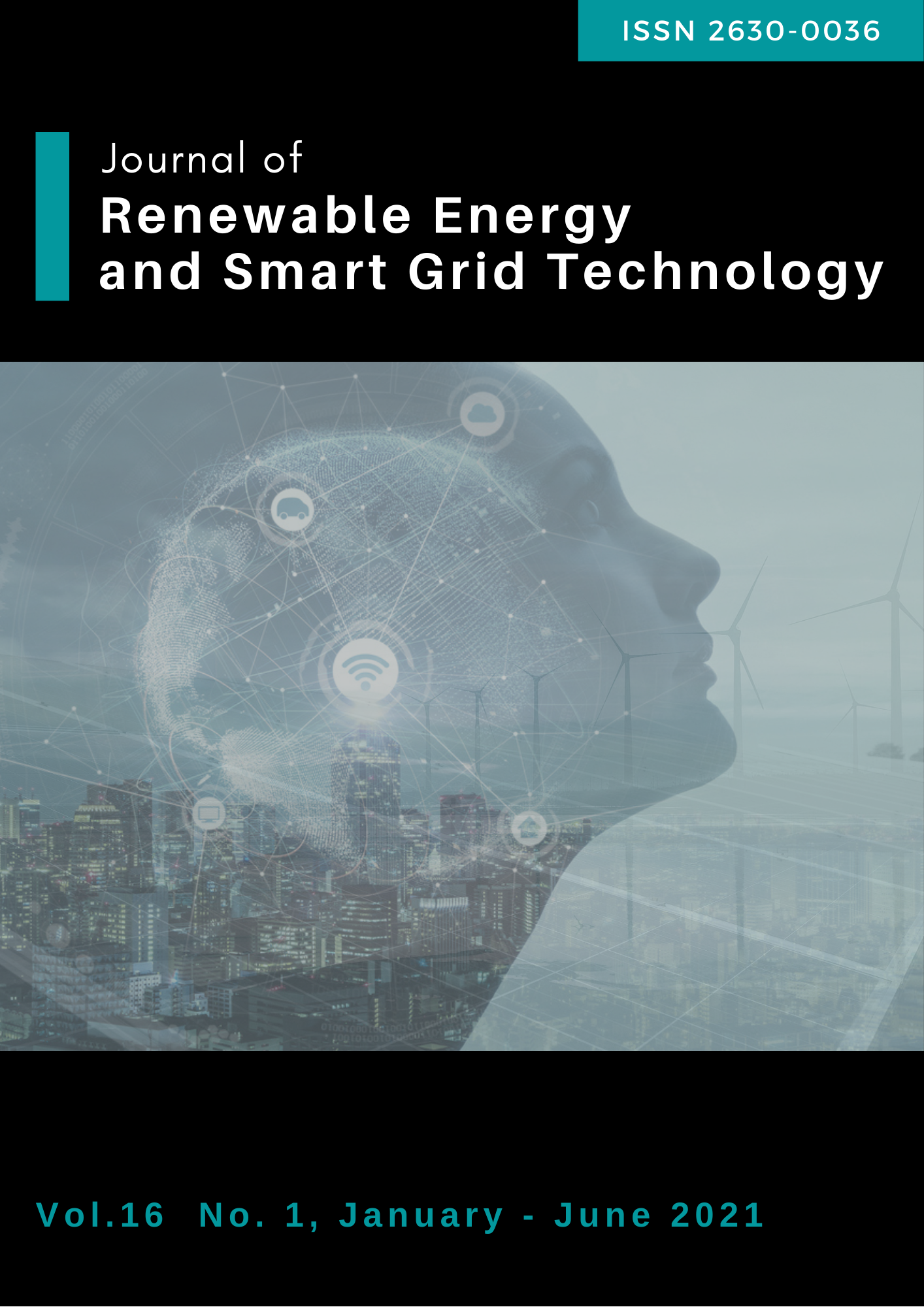An Analysis and Comparison of Battery Size Selection and Economic Worthiness of Two Industrial Plants based on Electricity-generating from Solar Power for Self-Consumption
Keywords:
Battery, Economic Worthiness, Electricity Generating, Solar EnergyAbstract
Industrial plants in Thailand have invested in the installation of the system of electricity-generating from solar energy for self-consumption. Sometimes, it has the excess power supply which could have a reverse power flow to the electrical system of the Provincial Electricity Authority. This is because some industrial plants install the electrical generation system which is more than the actual load or some periods of time that an industrial plant reduces energy uses. Consequently, this influences lack of power quality and its characteristic does not comply with power network system interconnection code of the Provincial Electricity Authority. However, it can be solved by the installation of appropriate battery sizes.
The purposes of this paper are to reduce reverse power generating from solar PV of industrial factory to PEA’s system and to decrease energy losses in term of self-consumption. This article analyses energy losses of electrical generation system from solar PV power, selection of appropriate battery size and its economic worthiness. Data from two industrial plants are analyzed based on electrical consumption patterns. The industrial plant 1 uses electricity during weekdays which is more than weekend whereas the industrial plant 2 uses an amount of electricity during weekend and weekdays which is almost the same. The analysis results show that factory 1 should select battery size of 34 kWh and factory 2 is able to choose battery size of 143 kWh or 268 kWh. This is because it can reduce impacts on power quality due to reserve power and strengthen system stability of the Provincial Electricity Authority. Also, it can generate increased revenue to the organization by selling the electricity surplus.
References
Energy Regulatory Commission. SPP/VSPP Database. Retrieved March 14, 2021, from http://www.erc.or.th/ERCSPP/default.aspx?x=0&muid=23&prid=41
Muneer, W., Bhattacharya, K., & Canizares, C. A. (2011). Large-scale solar PV investment models, tools, and analysis: The Ontario case. IEEE Transactions on Power Systems, 26(4), 2547-2555.
Suh, M. H., Kim, K. H., & Kwon, Y. I. (2012, June 26-28). Economic analysis of Korean photovoltaic power generation project. 8th International Conference on Information Science and Digital Content Technology (ICIDT2012), Jeju, South Korea.
Tang, Y., Burgos, R., Li, C., & Boroyevich, D. (2016, June 5-10). Impact of PV inverter generation on voltage profile and power loss in medium voltage distribution systems. IEEE 43rd Photovoltaic Specialists Conference (PVSC), Portland, OR, USA.
Vasudevan, K., Reddy Atla, C. S., & Balaraman, K. (2015, August 12-14). Impact of dispersed solar rooftop generation over the voltage profile in distribution system. 2015 International Conference on Power and Advanced Control Engineering (ICPACE), Bengaluru, India.
Karimi, M., Mokhlis, H., Naidu, K., Uddin, S., & Bakar, A. H. A. (2016). Photovoltaic penetration issues and impacts in distribution network-A review. Renewable and Sustainable Energy Reviews, 53, 594-605.
Haque, M. M., & Wolfs, P. (2016). A review of high PV penetration in LV distribution network: Present status impacts and mitigation measures. Renewable and Sustainable Energy Reviews, 62, 1195–1208.
Zhao, B., Zhang, X., Chen, J., Wang, C., & Guo, L. (2013). Operation optimization of standalone microgrids considering lifetime characteristics of battery energy storage system. IEEE Transactions on Sustainable Energy, 4(4), 934-943.
Hussain, A., Bui, V. H., & Kim, H. M. (2016). Fuzzy logic-based operation of battery energy storage systems (BESSs) for enhancing the resiliency of hybrid microgrids. Energies, 10(3), 271.
Mansiri, K., Sukchai, S., & Sirisamphanwong, C. (2018). Fuzzy control for smart PV-battery system management to stabilize grid voltage of 22 kV distribution system in Thailand. Energies, 11(7), 1730.
Mao, M., Jin, P., Chang, L., & Xu, H. (2014). Economic analysis and optimal design on microgrids with SS-PVs for industries. IEEE Transactions on Sustainable Energy, 5(4), 1328-1336.
Chaiyabin, J., Tanchaiyarojd, S., Jirasereeamornkul, K., Lenwari, W., Buochareon, S., & Auttawaitkul, Y. (2018, September 24-25). Analysis of economic for energy storage using size of batteries for self-use of solar power plants. PEACON & INNOVATION 2018, Bangkok, Thailand.
Provincial Electricity Authority. (2016). Provincial Electricity Authority On the terms of the power grid connection 2016. Retrieved July 14, 2018, from https://www.pea.co.th/Portals/0/Document/connection_code_2016_20170928.pdf
Chaiyabin, J., Tanchaiyarojd, S., Jirasereeamornkul, K., Lenwari, W., Buochareon, S., & Auttawaitkul, Y. (2018, September 24-25). Energy storage by using the appropriate battery size for reduce energy loss in the power generation system for self-use of solar power plants. PEACON & INNOVATION 2018, Bangkok, Thailand.
Zhou, N., Liu, N., Zhang, J., & Lei, J. (2016). Multi-objective optimal sizing for battery storage of PV-based microgrid with demand response. Energies, 9(8), 591.
Downloads
Published
How to Cite
Issue
Section
License
All copyrights of the above manuscript, including rights to publish in any media, are transferred to the SGtech.
The authors retain the following rights;
1. All proprietary rights other than copyright.
2. Re-use of all or part of the above manuscript in their work.
3. Reproduction of the above manuscript for author’s personal use or for company/institution use provided that
(a) prior permission of SGtech is obtained,
(b) the source and SGtech copyright notice are indicated, and
(c) the copies are not offered for sale.









